From optics to organic LEDs (OLEDS) to lasers, many sophisticated photonics technologies are being developed to help soldiers fire without drawing enemy fire, or to get a better understanding of the ever-changing situation on the battlefield.
Schott DiamondView Armor Products (Schott DAP) of Boothwyn, Pa., produces glass-ceramic armor that protects against blasts and projectiles while also being transparent enough to see through. The glass can take multiple hits from advanced sniper and improvised explosive devices (IEDs) and also provides far greater night-vision transparency than materials used previously. The glass-ceramic armor offers ultraviolet filtering and resistance to thermal cycling, and it weighs significantly less than traditional vehicular armor.
Schott’s NightViper optical scope, introduced by the company’s Fiber Optics Defense Div. last summer, allows soldiers on night operations to see what’s around corners, under doors, in vehicles or through holes in buildings before entering. NightViper, a flexible wound fiber optic bundle 2 to 6 ft long, attaches to standard 18-mm night-vision goggles to allow soldiers to see without being seen.
Schott’s low-viewing-angle fiber optic faceplates can allow soldiers to view electronic displays at night without illuminating themselves and drawing enemy fire. The faceplates can be used in LCD-, LED- and OLED-based displays.
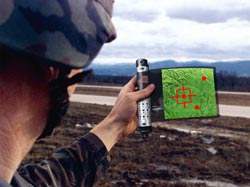
A prototype of a flexible display that rolls out like a scroll from a pen-like device that its creator, Universal Display Corp., calls the Universal Communication Device. It is envisioned as an energy-efficient, cell phone-like device that would offer advanced voice and data communication capabilities. Photo courtesy of Universal Display Corp.
A wrist-mount flexible OLED display for military applications being developed by Universal Display Corp. of Ewing, N.J., could give soldiers access to critical information that provides many tactical advantages, without their having to carry several pieces of bulky equipment. The company is developing the device under a $1 million, 15-month extension to its US Army Communications-Electronics Research, Development and Engineering Center (CERDEC) contract.
The active-matrix OLED (AMOLED) display combines the company’s phosphorescent OLED technology with an amorphous-silicon thin-film-transistor backplane made by LG Display, as well as Universal Display’s transparent cathode technology for top emission.
The technology gives the wearer the convenience of seeing real-time video and graphics on his or her wrist, and it uses less power, so carrying a lot of batteries is unnecessary.
Universal Display has developed a prototype of the device, which garnered many “oohs and aahs” during the Consumer Electronics Show in January. During this next contract phase, the company wants to make the display brighter and further improve the design so it’s thinner, lighter and in a more compact housing.
Right now, “it’s a fairly large device – there are some hefty electronics in there,” said Janice K. Mahon, vice president of technology commercialization for Universal Display. There also has been some talk of adding more capabilities, such as touch, she said, although it’s not yet clear if it will be done in this contract phase.
Prototypes will be delivered to the military so it can evaluate the usefulness of having the device wrist-mounted as opposed to handheld.
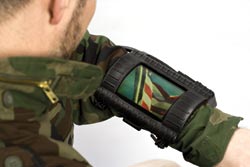
A wrist-mounted flexible OLED display prototype designed by Universal Display Corp. and its partners, LG Display and L-3 Display Systems. Several have been delivered to the US Army for testing and evaluation. Under a contract extension, Universal Display will focus on making the device thinner, lighter and more compact. Photo courtesy of Universal Display Corp.
Another flexible display that Universal Display is working on for the military looks like a pen but has an OLED screen inside that can be rolled in and out like a scroll. The full-color, touch-sensitive display might one day be used to provide soldiers in the field real-time maps of enemy troop movements and could also function as a cell phone-like communication device.
While flexible displays are not yet ready to be flexed “a gazillion” times, “we have demonstrated thousands of hours of operation in the prototype we delivered to the Army,” Mahon said.
Since 2004 Universal Display has been developing infrared-emitting OLEDs that can be used in both daytime and nighttime displays and in high-, low-, or no-light conditions, and that can be switched from visible to infrared light-emitting so the display can’t be seen without special eyewear.
“One of OLEDs’ benefits is that they are dynamically tunable. You can turn them from very low brightness to very high. In the IR pixel we demonstrated for the military, during the day it’s monochrome green. At night, you could turn the green off, and you would have IR emission for night vision,” Mahon said.
While advanced optics and OLEDs are making their way into the hands of troops, some low-energy laser weapons are already being used on the battlefield. Advances in electrically based solid-state and fiber lasers have made useful low-power applications achievable. These include nonlethal applications at power levels of less than 1 W to tens of watts of average power.
Such laser-based “optical incapacitation” devices have been used in Iraq to warn or temporarily incapacitate individuals, and green laser (532 nm) systems currently used by Marines at vehicle checkpoints, during convoy operations and on patrols can dazzle or temporarily blind people at a distance of 300 m or more.
The Personnel Halting and Stimulation Response, or PHaSR, is a rifle-size laser weapon system that uses two nonlethal wavelengths to “dazzle” aggressors. The PHaSR sends a beam of laser light that illuminates the enemy, temporarily blinding him. The system uses two low-power diode-pumped lasers, one visible wavelength and one in the mid-infrared region.
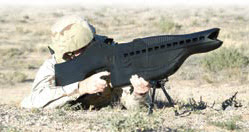
The Personnel Halting and Stimulation Response (PHaSR) is a rifle-sized laser weapon system that uses two nonlethal laser wavelengths to illuminate or “dazzle” aggressors, temporarily pairing individuals and their ability to see the laser source. Photo courtesy of US Air Force.
Previous illuminator lasers have been too powerful at close ranges and ineffective at long ranges when they’re made eye-safe. The PHaSR incorporates an eye-safe laser rangefinder so the maximum safe laser energy can be placed on target, regardless of range.
As part of the 2009 Defense Appropriations Bill, the defense secretary was given until Jan. 1, 2010, to submit a report to Congress on implementation of the Defense Science Board’s December 2007 recommendations that the military focus on directed energy weapons such as low-, medium- and high-power lasers, high-power microwaves and millimeter waves.
One such directed energy weapon is the Airborne Laser (ABL), in development since 1994. The ABL consists of a modified Boeing 747 aircraft: The back half holds the high-energy laser designed by Northrop Grumman Corp. to destroy ballistic missiles just as they take off, while the front half contains the beam control/fire control system developed by Lockheed Martin and the battle management system provided by Boeing Co., the prime contractor on the project. The high-energy chemical laser beam heats the missile’s pressurized body enough to crack it, causing it to explode. Three other lasers aboard the craft help detect and track missiles.
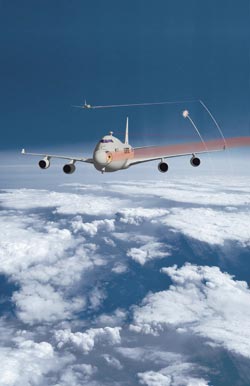
A artist's impression of the Airborne Laser system in operation. Image courtesy of The Boeing Co.
The US Missile Defense Agency successfully operated the ABL’s complete weapon system for the first time in December. During the ground test, a beam from the megawatt-class chemical oxygen iodine laser (COIL) traveled the length of the aircraft at 670 million mph, racing out through the nose-mounted turret for the first time.
Lasting up to three seconds each, the lethal-power firings were conducted to “tune” the megawatt-class laser by adjusting and balancing the mixture of chemicals that fuel its engine for peak operating efficiency. Those settings will be used for future testing, including the planned shoot down of a ballistic missile later this year.
Boeing’s advanced tactical laser (ATL) is a high-energy laser system aboard a C-130 aircraft that will be used against ground targets. The ATL fired its high-energy chemical laser through its beam control system during a test in August. The beam control system acquired a ground target and guided the laser beam to the target, as directed by ATL’s battle management system. The laser passes through a rotating turret on the aircraft’s belly.
In January, Boeing announced that it has successfully showed that a laser system mounted on an Avenger combat vehicle can shoot down a small unmanned aerial vehicle.
“Small [unmanned aerial vehicles] armed with explosives or equipped with surveillance sensors are a growing threat on the battlefield,” said Gary Fitzmire, vice president and program director of Boeing Directed Energy Systems. “Laser Avenger, unlike a conventional weapon, can fire its laser beam without creating missile exhaust or gun flashes that would reveal its position.”
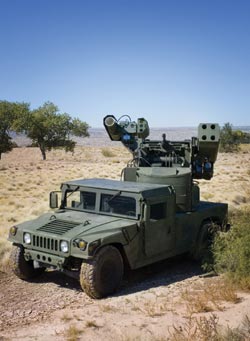
Laser Avenger, developed by Boeing Directed Energy Systems in Albuquerque, N.M., and Boeing Combat Systems in Huntsville, Ala., integrates a directed energy weapon together with kinetic weapons to shoot down unmanned aerial vehicles or neutralize ground threats such as improvised explosive devices and unexploded ordnance. Unlike a conventional weapon, Laser Avenger can fire its laser beam without creating exhaust or flashes that would reveal its position. Image courtesy of The Boeing Co.
In previous tests, the Avenger neutralized improvised explosive devices and unexploded ordnance on the ground. After those tests, Boeing doubled the laser power, added better acquisition, tracking and pointing capabilities, and simplified and ruggedized the design.
The Firestrike laser, the first high-energy solid-state laser for battlefield applications, was introduced by Northrop Grumman in November. Each 400-lb, 15-kW laser unit can be combined with up to eight others to fit specific missions and/or platforms. The solid-state laser is a big advance for battlefield lasers, which previously had to use chemicals to achieve lethal power levels. However, Firestrike is less powerful than the chemical-based lasers on ABL or ATL, for now.